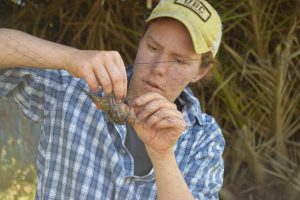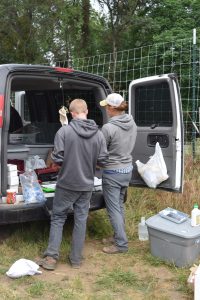Molecular Quantification of Wild Birds’ Risk of Spreading Pathogens and Parasites
We are using a novel technique called molecular scatology to document pathogen presence in wild bird feces on organic farms. First, we collect feces from wild birds. Birds will be captured twice per year per farm for two years using a technique called mist netting (Fig. 1). After birds are captured, they are temporarily held in bags designed for safe handling until they defecate. We then collect body measurements, blood samples, and feathers for further analysis (Fig. 2). The birds are then released back into the wild. After the field season, the samples are primed using a method called Polymerase Chain Reaction (PCR) with primers developed by Dr. Chaoyang Zhao and then sent to Dr. Erin Wilson Rankin at UC Riverside to use next-generation sequencing and checked against the GENBANK DNA-sequence database to determine what the microorganisms the birds vector. We will specifically screen for E. coli, Salmonella enterica, Mycobacteria, Campylobacter, Helicobactor, Brachyspira, and Eimeria. We will additionally screen the blood samples for parasites and West Nile Virus. Because of the sensitive nature of these data for our cooperating growers, parasite/pathogen data will never be linked to particular farms (or even farm locations) in any resulting journal or outreach publications.


Quantification of Mosquitoes Present on Farms
Farms are ideal places for West Nile virus to propagate, with irrigation water providing ideal breeding grounds for mosquitoes and birds acting as reservoirs for the virus. It is important to know what landscape features are associated with Culex mosquitoes (a species of mosquito that is an important vector of WNV) in order to make informed land use decisions with regards to agriculture. Mosquito traps were placed varying habitat types on the farms to quantify the presence of different mosquito species. It is important to ground truth the idea that certain farming practices can result in higher mosquito populations and higher rates of disease. We are currently in the process of analyzing data and writing results.






